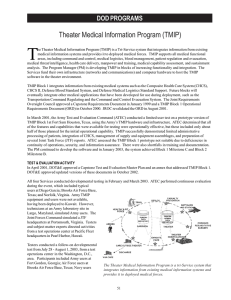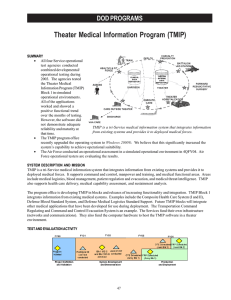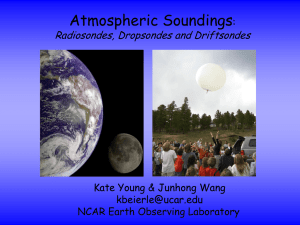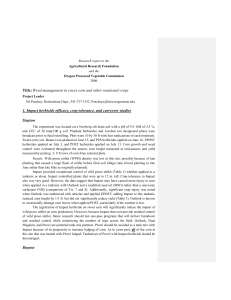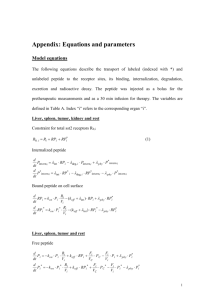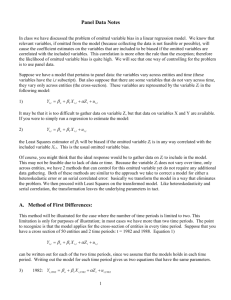HYDROGRAPHIC SURVEYING AND FLOW MEASUREMENTS
advertisement
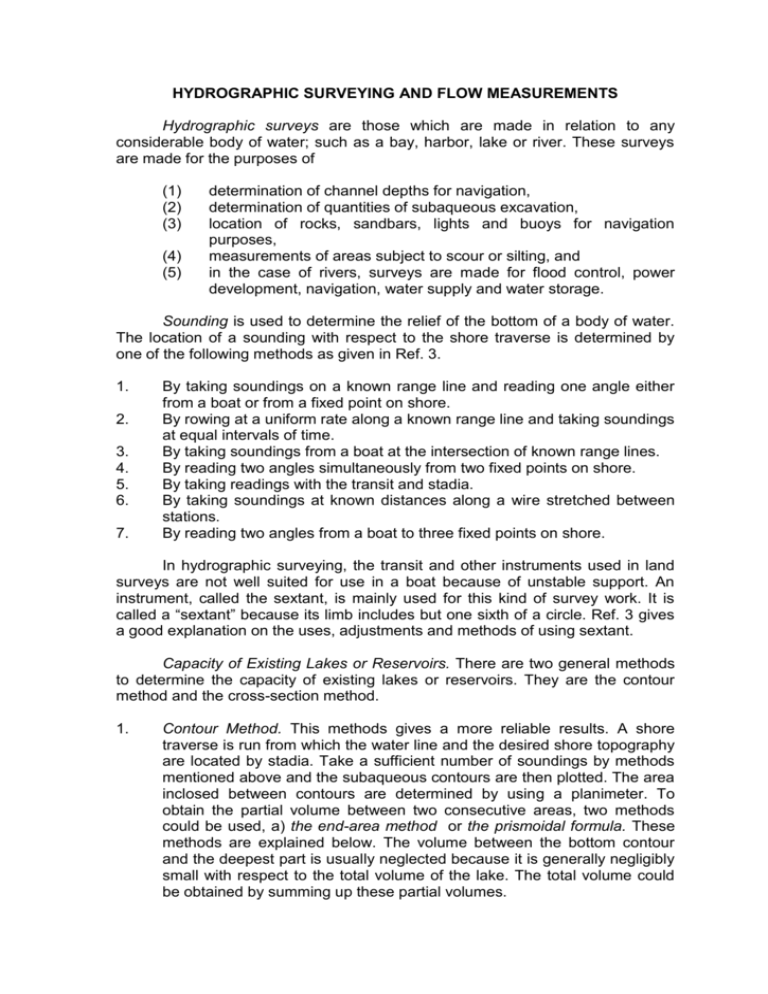
HYDROGRAPHIC SURVEYING AND FLOW MEASUREMENTS Hydrographic surveys are those which are made in relation to any considerable body of water; such as a bay, harbor, lake or river. These surveys are made for the purposes of (1) (2) (3) (4) (5) determination of channel depths for navigation, determination of quantities of subaqueous excavation, location of rocks, sandbars, lights and buoys for navigation purposes, measurements of areas subject to scour or silting, and in the case of rivers, surveys are made for flood control, power development, navigation, water supply and water storage. Sounding is used to determine the relief of the bottom of a body of water. The location of a sounding with respect to the shore traverse is determined by one of the following methods as given in Ref. 3. 1. 2. 3. 4. 5. 6. 7. By taking soundings on a known range line and reading one angle either from a boat or from a fixed point on shore. By rowing at a uniform rate along a known range line and taking soundings at equal intervals of time. By taking soundings from a boat at the intersection of known range lines. By reading two angles simultaneously from two fixed points on shore. By taking readings with the transit and stadia. By taking soundings at known distances along a wire stretched between stations. By reading two angles from a boat to three fixed points on shore. In hydrographic surveying, the transit and other instruments used in land surveys are not well suited for use in a boat because of unstable support. An instrument, called the sextant, is mainly used for this kind of survey work. It is called a “sextant” because its limb includes but one sixth of a circle. Ref. 3 gives a good explanation on the uses, adjustments and methods of using sextant. Capacity of Existing Lakes or Reservoirs. There are two general methods to determine the capacity of existing lakes or reservoirs. They are the contour method and the cross-section method. 1. Contour Method. This methods gives a more reliable results. A shore traverse is run from which the water line and the desired shore topography are located by stadia. Take a sufficient number of soundings by methods mentioned above and the subaqueous contours are then plotted. The area inclosed between contours are determined by using a planimeter. To obtain the partial volume between two consecutive areas, two methods could be used, a) the end-area method or the prismoidal formula. These methods are explained below. The volume between the bottom contour and the deepest part is usually neglected because it is generally negligibly small with respect to the total volume of the lake. The total volume could be obtained by summing up these partial volumes. 2. Cross-section Method. This method is used when only a moderate degree of precision is required. The outline of the water surface is obtained as in the contour method. The water outline is then plotted and divided into approximate trapezoids and triangles. The boundary lines between trapezoids or between trapezoids and triangles are on the sections where soundings are taken using any suitable method of location. The perpendicular distances between sections and altitudes of all triangles are determined by field measurement. The approximate volume between cross-section is computed by end-area method or prismoidal formula and the sum of these volumes is the total estimated volume. Flow Measurement. Discharge measurements of a stream are usually made in connection with problems of water supply, power development, and flood flow. Discharge is the rate at which the water in a stream flow past a given section. The units of discharge commonly employed using the English System is gallons per day or liters per second in S.I. Units. The determination of the amount of water flowing past a given section in a given time is called discharge measurement. The discharge rate is the product of two factors, the crosssectional area and the mean forward velocity of the water in the section where the area is measured. In equation form, that is where: Q =AV Q = discharge rate, liters/sec., cu.m./sec. A = cross-sectional area, sq. m. V = the mean-forward velocity of he water, m/s. Measuring the Cross-section. The cross-section of the stream is preferably measured at low water. Starting above high-water level, a profile of both banks, and of the water section as far as wading is possible, is secured by leveling. Sounding is used for deeper sections afterwards. The distance between soundings depends upon factors such as the width of the stream, the shape of stream bed, and the accuracy desired. Measuring Current Velocity. Current velocities could be determined by the use of floats or by the use of a current meter. The three common types of floats used in measuring stream velocity are surface, subsurface, and rod floats. Surface floats are the quickest and the most economical, while the subsurface floats give more accurate results. The current meter is an instrument used to measure the stream velocity indirectly. There are several current meter designs available. These are the Price Meter, Ellis Meter, Haskell Meter, Fteley Meter, and Hoff Meter. Ref. 3 gives a detailed description of these meters. Velocity Measurements. The velocity desired in discharge measurement is the mean horizontal velocity in a vertical line at the measuring point. The five common methods to obtain this value are: (1) vertical-velocity-curve method, (2) two-tenths and eight-tenths method, (3) six-tenths method, (4) integration method, and (5) subsurface method. The Contour Method of Determining the Capacity of a Body of Water. The two contour methods, end-area method and the prismoidal formula, of determining the capacity of a body of water will be derived as follows: A1 A2 h A3 h A4 h A5 Figure 8.1 h Employing end-area method on the contours of the lake. End-area method. Deriving the equation for end-area method using Fig. 8.1, V1-2 = (1/2)(A1 + A2) h V2-3 = (1/2)(A2 + A3) h V3-4 = (1/2)(A3 + A4) h V4-5 = (1/2)(A4 + A5) h VTOTAL = V1-2 + V2-3 + V3-4 + V3-5 VTOTAL = (1/2)(A1 + A2) h + (1/2)(A2 + A3) h + (1/2)(A3 + A4) h + (1/2)(A4 + A5) h VTOTAL = (h/2)(A1 + 2A2 + 2A3 + 2A4 + A5) The general equation is therefore given by VTOTAL = (h/2)[A1 + AN + 2( middle areas)], where N is the last area. The areas A1, A2,... AN are determined by using a planimeter and h represents the contour interval. Area below AN is neglected. Prismoidal Formula. The basic prismoidal formula is V = (L/6)(AF + 4 AM + AE) AF is the front area AM is the middle area AE is the end area Still considering Fig. 8.1, the middle area AM is the areas A2 and A4 while L is equivalent to 2h. where: V1-3 = (2h/6)(A1 + 4A2 + A3) V3-5 = (2h/6)(A3 + 4A4 + A5) VTOTAL = V1-3 + V3-5 VTOTAL = (h/3)(A1 + 4A2 + A3) + (h/3)(A3 + 4A4 + A5) Simplifying, VTOTAL = (h/3)(A1 + 4A2 + 2A3 + 4A4 + A5) The general equation is therefore given by VTOTAL = (h/3)[A1 + AN + 2( Odd Areas) + 4( Even Areas)] where: N in AN is always an odd area and the ( odd areas) does not include N. If N is even, use end-area method for the section AN-1 to AN. The Parallel Cross-Section Method of Determining the Capacity of a Body of Water. In the same manner, for this process, end-area method and prismoidal formula could be applied in determining the capacity of a body of water. End-area Method. For end-area method shown in Fig. 8.2, parallel ranges are laid out across the lake and soundings are then taken along the ranges. From the observed sounding, the corresponding cross-sections could be plotted and its corresponding areas would then be computed. Such that, V1-2 = (1/2)(A1 + A2) h1 V3-4 = (1/2)(A3 + A4) h3 V5-6 = (1/2)(A5 + A6) h5 V2-3 = (1/2)(A2 + A3) h2 V4-5 = (1/2)(A4 + A5) h4 V6-7 = (1/2)(A6 + A7) h6 VTOTAL = V1-2 + V2-3 + V3-4 + V4-5 + V5-6 + V6-7 Because the perpendicular distance, h, between areas are not similar, there is no simplified form for the equation of the total volume. h1 h2 h3 h4 A1 h5 A2 h6 A3 A4 A7 A5 Figure 8.2 A6 Employing end-area method on the parallel cross-section of the lake. Prismoidal Formula. The problem will arise here in the determination of the middle area, AM, between the adjacent sections because the perpendicular distance h between the sections are not equal. It is therefore necessary to evaluate or interpolate AM for each adjacent sections. h1 h1/2 h2 h1/2 h2/2 h2/2 h3 h4 A1 h5 A2 h6 A3 A4 A7 A5 Figure 8.3 A6 Applying the prismoidal formula to the parallel cross-section of the lake. Considering Fig. 8.3, V1-2 = (h1/6)(A1 + 4AM + A2) V3-4 = (h3/6)(A3 + 4AM + A4) V5-6 = (h5/6)(A5 + 4AM + A6) V2-3 = (h2/6)(A2 + 4AM + A3) V4-5 = (h4/6)(A4 + 4AM + A5) V6-7 = (h6/6)(A6 + 4AM + A7) VTOTAL = V1-2 + V2-3 + V3-4 + V4-5 + V5-6 + V6-7



